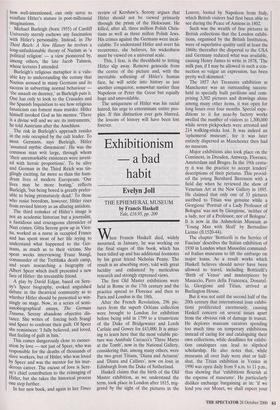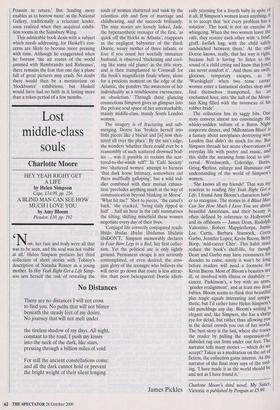Exhibitionism a bad habit
Evelyn Joll
THE EPHEMERAL MUSEUM by Francis Haskell Yale, L16.95, pp. 200 When Francis Haskell died, widely mourned, in January, he was working on the final stages of this book, which has been tidied up and has additional footnotes by his great friend Nicholas Penny. The result is an absorbing story, told with great lucidity and enhanced by meticulous research and strongly expressed views.
The first Old Master exhibitions were held in Rome in the 17th century and the practice spread to Florence and then to Paris and London in the 18th.
After the French Revolution, 296 pic- tures from the superb Orleans collection were brought to London for exhibition before being sold in 1799 to a triumvirate of the Duke of Bridgewater and Lords Carlisle and Gower for £43,000. It is amaz- ing to learn here that the most valuble pic- ture was Annibale Carracci's 'Three Marys at the Tomb', now in the National Gallery, considering that, among many others, were the two great Titians, 'Diana and Actaeon' and 'Diana and Callisto', now on loan in Edinburgh from the Duke of Sutherland.
Haskell claims that the birth of the Old Master exhibition, as we understand the term, took place in London after 1815, trig- gered by the sight of the pictures in the Louvre, looted by Napoleon from Italy, which British visitors had first been able to see during the Peace of Amiens in 1802.
Such was the wealth of fine pictures in British collections that the London exhibi- tions, organised by the British Institution, were of superlative quality until at least the 1860s; thereafter the dispersal to the USA and Germany reduced what was available, causing Henry James to write in 1878, 'The milk pan, if I may be allowed in such a con- nection so vulgar an expression, has been pretty well skimmed.'
The 1857 Art Treasures exhibition at Manchester was an outstanding success: held in specially built pavilions and com- prising 3,502 pictures and drawings alone among many other items, it was open for long hours over four months. Special expe- ditions to it for near-by factory works swelled the number of visitors to 1,300,000 while seven pickpockets were arrested and 214 walking-sticks lost. It was indeed an `ephemeral museum', for it was later entirely dispersed as Manchester then had no museum.
Major exhibitions also took place on the Continent, in Dresden, Antwerp, Florence, Amsterdam and Bruges. In the 19th centu- ry it was the practice to accept lenders' descriptions of their pictures. This provid- ed the young Bernhard Berenson with a field day when he reviewed the show of Venetian Art at the New Gallery in 1895. He claimed that only one of 33 pictures ascribed to Titian was genuine while a Giorgione 'Portrait of a Lady Professor of Bologna' was not by Giorgione, 'neither of a lady, nor of a Professor, nor of Bologna'. It is now in the Ashmolean Museum as `Young Man with Skull' by Bernadino Licinio (fl.1520-44).
The chapter `Botticelli in the Service of Fascism' describes the Italian exhibition of 1930 in London when Mussolini command- ed Italian museums to lift the embargo on major loans. As a result works which Haskell believes should never have been allowed to travel, including Botticelli's `Birth of Venus' and masterpieces by Masaccio, Piero della Francesca, Donatel- lo, Giorgione and Titian, arrived at Burlington House.
But it was not until the second half of the 20th century that international loan exhibi- tions proliferated enormously, causing Haskell concern on several issues apart from the obvious risk of damage in transit. He deplores museum curators spending too much time on temporary exhibitions instead of caring for and cataloguing their own collections, while deadlines for exhibi- tion catalogues can lead to slipshod scholarship. He also notes that, while museums all over Italy were shut or half- shut, the Titian exhibition in Venice in 1990 was open daily from 9 a.m. to 11 p.m., thus showing that 'exhibitions flourish at the expense of museums'. He particularly dislikes exchange bargaining as in: 'if we lend you our Monet, we shall expect your Poussin in return.' But 'lending more enables us to borrow more' as the National Gallery, traditionally a reluctant lender, soon realised when they acquired exhibi- tion rooms in the Sainsbury Wing.
This admirable book deals with a subject which needs addressing, for Haskell's con- cerns are likely to become more pressing with time. Although he exaggerated when he foresaw 'the air routes of the world jammed with Rembrandts and Rubenses', there remains the fear that one day a plane full of great pictures may crash. No doubt there would then be a moratorium on `blockbuster' exhibitions, but Haskell would have had no faith in it lasting more than a token period of a few months.



























































































 Previous page
Previous page